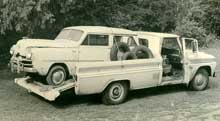I believe that cars belong on roads, not trailers. I used to think nothing of driving Angus the Hudson fifty miles each way to attend a show, but I’ve softened somewhat. I’ve owned trailers for more than thirty years, principally for moving cars that don’t run or are unregistered, so now sometimes I’ll load Angus and haul him, so as to travel at freeway speeds. Trailers are cumbersome, though. So how about a car that needs no trailer, is easily carried in the back of a pickup? Consider, friends, consider the Crosley.
Powel Crosley, Jr. was a marketing and inventing genius. Pioneering the low-cost radio receiver he then founded WLW, a high power broadcasting station in Cincinnati, Ohio, to give his radios something to receive. His Crosley Shelvador refrigerator set the pattern for all modern fridges. In the late 1930s, he sought to bring America a small, low-cost car. His Crosley automobile, introduced in 1939, was a spartan roadster powered by an air-cooled Waukesha flat twin engine.
After World War II, Crosley brought his car somewhat upmarket, with a four-cylinder engine designed by Lloyd Taylor for military use. With a block of steel cylinders and tin-plated sheet metal water jacket, and shaft driven overhead cam, the Crosley Cobra (COpper BRAzed) weighed 58 pounds in fighting trim. A whole line of automobiles – the only totally new 1946 cars – was built around it. There were two-door sedans (this a ’47), station wagons (’48 and ’51), convertibles (’49 and ’51) and pickup trucks (’47). In 1949, a sports model, the Hotshot, was introduced – later the Hotshot was joined by a Super Sports model with doors. There was a panel delivery and a Jeep-like thing called the FarmOroad. By 1952, though, it was all over. Sales, which had topped 25,000 in 1948, shrank to less than a tenth of that. Powel pulled the plug on the car business.
The Cobra engine had a fatal flaw in that electolysis destroyed the lightweight blocks. The fix was the CIBA engine – Cast Iron Block Assembly. With an iron block the little Crosley cammer became a high-revving competition engine and eventually found service as an outboard motor under the Homelite name, and as the Fisher-Pierce Bearcat by the builder of Boston Whaler boats. The FarmOroad, too, saw later life as an industrial vehicle called the Crofton Bug. There’s tons more information on Crosleys at the website of the Crosley Automobile Club.
My high school friend Tod had a Crosley, a 1949 sedan with the CIBA engine – and disc brakes. The week after graduation in 1962 we drove it to Cape Cod, a 200-mile trip. Even for a couple of hormone-charged adolescents, the Crosley was uncomfortable. Girls thought it cute, and would wave when we honked, but they preferred to ride in cars with V8s and glass packs. We challenged a Vespa scooter to a stoplight drag – and lost.
Tod had a parts car, a ’51 station wagon whose transmission and rear axle had been removed to build a tractor. When he moved to the west coast, I bought it and took it home in my Chevy pickup – no trailer needed.

